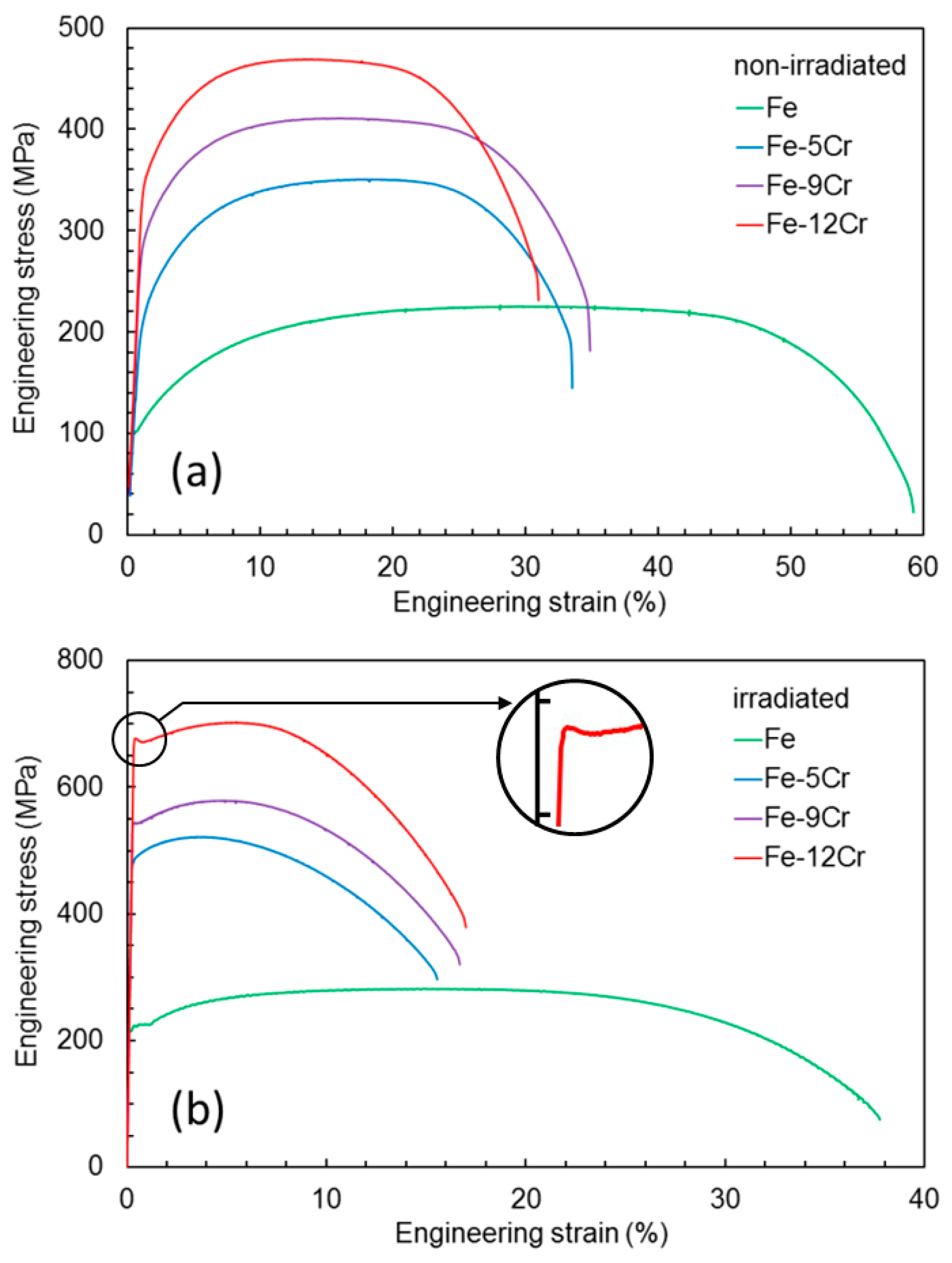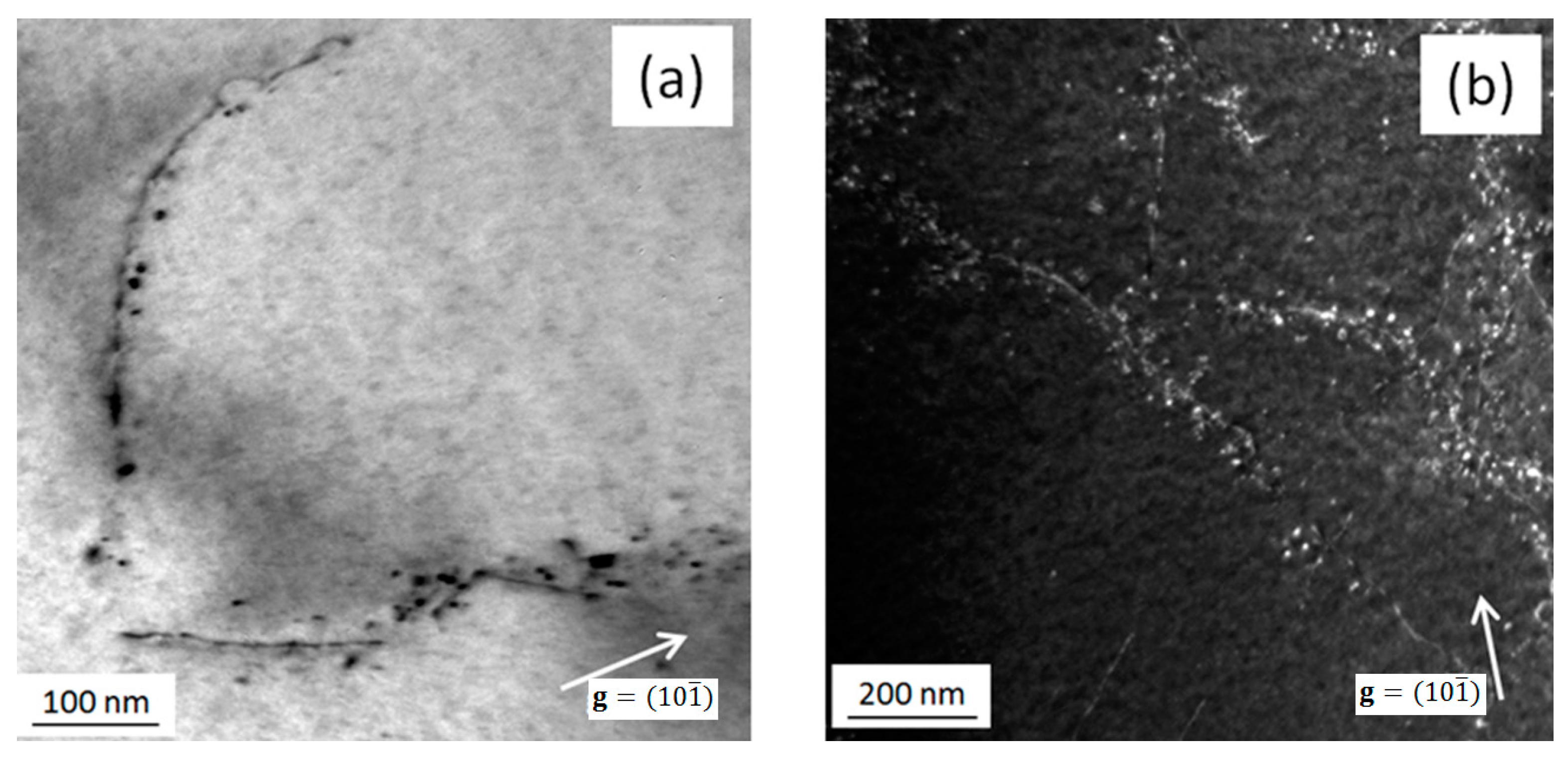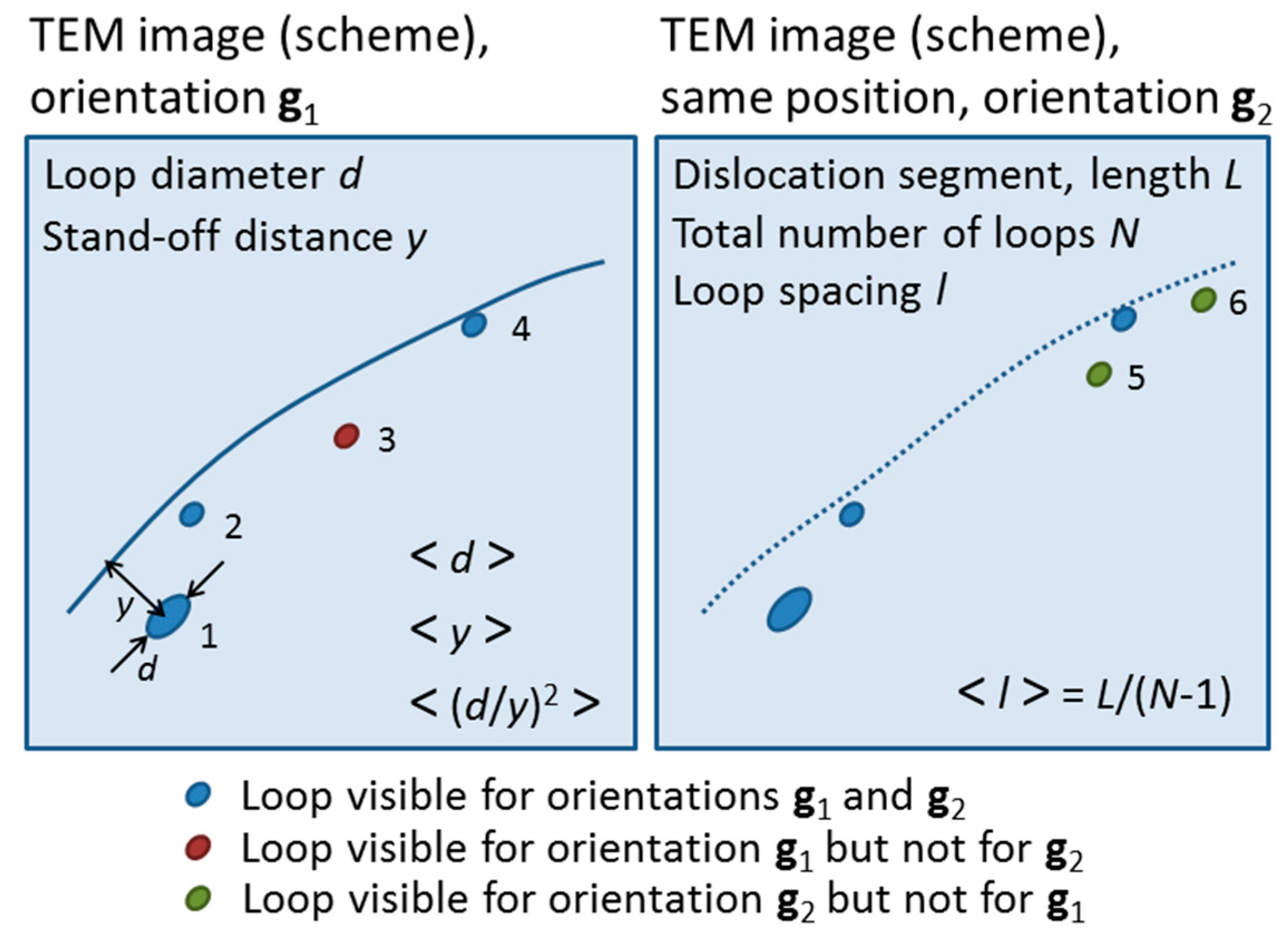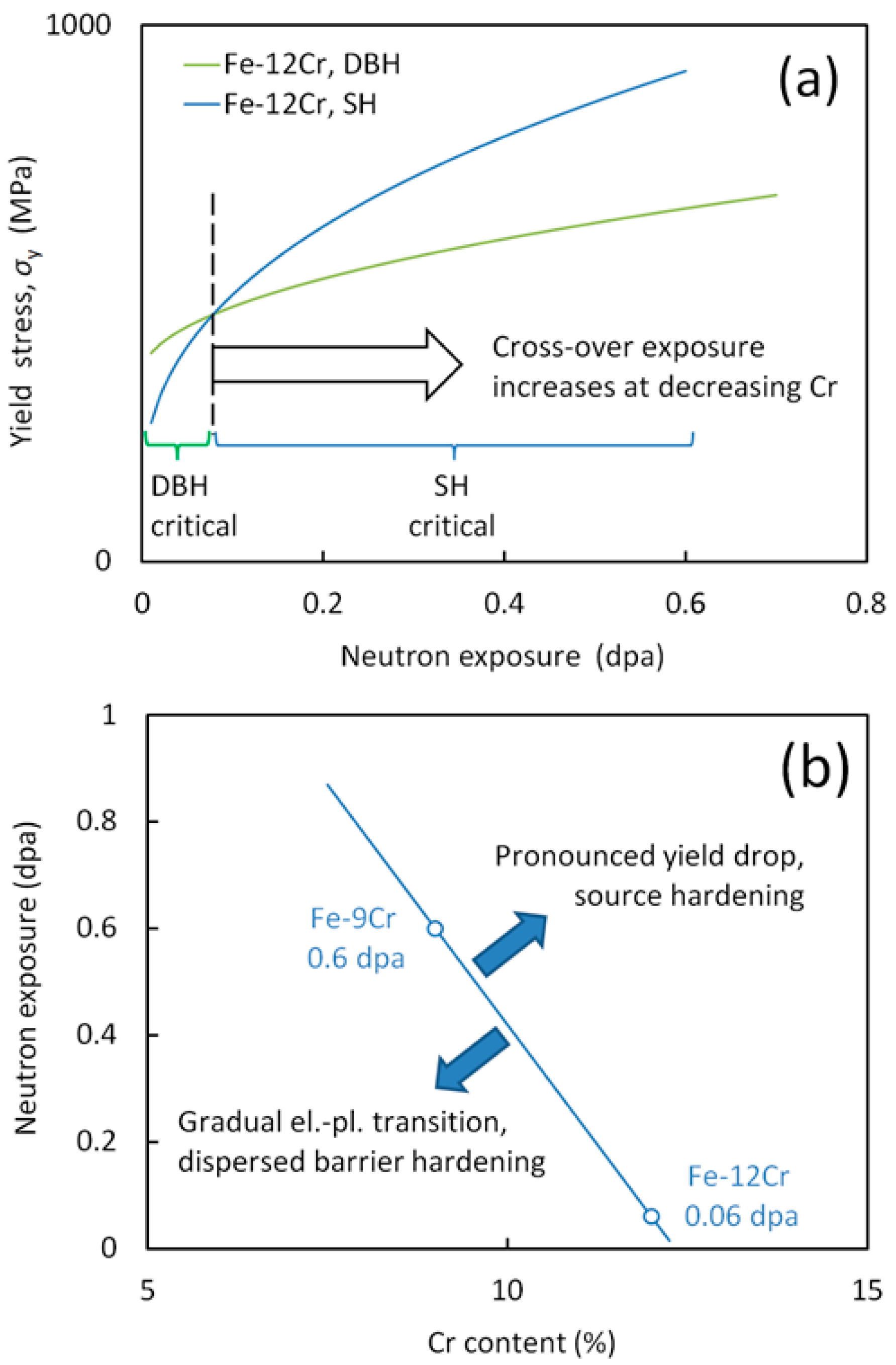TEM Observation of Loops Decorating Dislocations and Resulting Source Hardening of Neutron-Irradiated Fe-Cr Alloys
Abstract
1. Introduction
2. Materials and Methods
3. Results
3.1. Stress-Strain Curves
3.2. Irradiation-Induced Microstructure
4. Discussion
Author Contributions
Funding
Acknowledgments
Conflicts of Interest
References
- Orowan, E. Symposium on Internal Stresses in Metals and Alloys; The Institute of Metals: London, UK, 1948. [Google Scholar]
- Seeger, A.K. On the theory of radiation damage and radiation hardening. In Proceedings of the Second United Nations International Conference on The Peaceful Uses of Atomic Energy, Geneva, Switzerland, 1–13 September 1958; Volume 6, pp. 250–273. [Google Scholar]
- Bacon, D.J.; Kocks, U.F.; Scattergood, R.O. The effect of dislocation self-interaction on the Orowan stress. Philos. Mag. 1973, 28, 1241–1263. [Google Scholar] [CrossRef]
- Singh, B.N.; Foreman, A.J.E.; Trinkaus, H. Radiation hardening revisited: Role of intracascade clustering. J. Nucl. Mater. 1997, 249, 103–115. [Google Scholar] [CrossRef]
- Trinkaus, H.; Singh, B.N.; Foreman, A.J.E. Segregation of cascade induced interstitial loops at dislocations: Possible effect on initiation of plastic deformation. J. Nucl. Mater. 1997, 251, 172–187. [Google Scholar] [CrossRef]
- Diaz de la Rubia, T.; Zbib, H.M.; Khraishi, T.A.; Wirth, B.D.; Victoria, M.; Caturla, M.J. Multiscale modelling of plastic flow localization in irradiated materials. Nature 2000, 406, 871–874. [Google Scholar] [CrossRef]
- Kroupa, P. The interaction between prismatic dislocation loops and straight dislocations. part I. Philos. Mag. 1961, 7, 783–801. [Google Scholar] [CrossRef]
- Robertson, I.M.; Jenkins, M.L.; English, C.A. Low-dose neutron-irradiation damage in α-iron. J. Nucl. Mater. 1982, 108–109, 209–221. [Google Scholar] [CrossRef]
- Eldrup, M.; Singh, B.N.; Zinkle, S.J.; Byun, T.S.; Farrell, K. Dose dependence of defect accumulation in neutron irradiated copper and iron. J. Nucl. Mater. 2002, 307–311, 912–917. [Google Scholar] [CrossRef]
- Luft, A. Microstructural processes of plastic instabilities in strengthened metals. Prog. Mater. Sci. 1991, 35, 97–204. [Google Scholar] [CrossRef]
- Zinkle, S.J.; Singh, B.N. Microstructure of neutron-irradiated iron before and after tensile deformation. J. Nucl. Mater. 2006, 351, 269–284. [Google Scholar] [CrossRef]
- Cottrell, A.H.; Bilby, B.A. Dislocation theory of yielding and strain ageing of iron. Proc. Phys. Soc. A 1949, 62, 49–62. [Google Scholar] [CrossRef]
- Matijasevic, M.; Almazouzi, A. Effect of Cr on the mechanical properties and microstructure of Fe–Cr model alloys after n-irradiation. J. Nucl. Mater. 2008, 377, 147–154. [Google Scholar] [CrossRef]
- Bergner, F.; Pareige, C.; Hernández-Mayoral, M.; Malerba, L.; Heintze, C. Application of a three-feature dispersed-barrier hardening model to neutron-irradiated Fe–Cr model alloys. J. Nucl. Mater. 2014, 448, 96–102. [Google Scholar] [CrossRef]
- Hernandez-Mayoral, M.; Heintze, C.; Oñorbe, E. Transmission electron microscopy investigation of the microstructure of Fe-Cr alloys induced by neutron and ion irradiation at 300 °C. J. Nucl. Mater. 2016, 474, 88–98. [Google Scholar] [CrossRef]
- Kuksenko, V.; Pareige, C.; Pareige, P. Cr precipitation in neutron irradiated industrial purity Fe–Cr model alloys. J. Nucl. Mater. 2013, 432, 160–165. [Google Scholar] [CrossRef]
- Heintze, C.; Bergner, F.; Ulbricht, A.; Eckerlebe, H. The microstructure of neutron-irradiated Fe–Cr alloys: A small-angle neutron scattering study. J. Nucl. Mater. 2011, 409, 106–111. [Google Scholar] [CrossRef]
- Lambrecht, M.; Malerba, L. Positron annihilation spectroscopy on binary Fe–Cr alloys and ferritic/martensitic steels after neutron irradiation. Acta Mater. 2011, 59, 6547–6555. [Google Scholar] [CrossRef]
- Konstantinović, M.J.; Van Renterghem, W.; Matijašević, M.; Minov, B.; Lambrecht, M.; Toyama, T.; Chiapetto, M.; Malerba, L. Mechanical and microstructural properties of neutron irradiated Fe–Cr–C alloys. Phys. Status Solidi A 2016, 213, 2988–2994. [Google Scholar] [CrossRef]
- Norgett, M.J.; Robinson, M.T.; Torrens, I.M. A proposed method of calculating displacement dose rates. Nucl. Eng. Des. 1975, 33, 50–54. [Google Scholar] [CrossRef]
- Lambrecht, M.; Malerba, L.; Almazouzi, A. Influence of different chemical elements on irradiation-induced hardening embrittlement of RPV steels. J. Nucl. Mater. 2008, 378, 282–290. [Google Scholar] [CrossRef]
- Hernández-Mayoral, M.; Gómez-Briceño, D. Transmission electron microscopy study on neutron irradiated pure iron and RPV model alloys. J. Nucl. Mater. 2010, 399, 146–153. [Google Scholar] [CrossRef]
- Bergner, F.; Ulbricht, A.; Hernandez-Mayoral, M.; Pranzas, P.K. Small-angle neutron scattering study of neutron-irradiated iron and an iron–nickel alloy. J. Nucl. Mater. 2008, 374, 334–337. [Google Scholar] [CrossRef]
- Edington, J.W. Practical Electron Microscopy in Materials Science; Macmillan, Philips Technical Library: London, UK, 1975. [Google Scholar]
- Jenkins, M.L.; Kirk, M.A. Characterization of Radiation Damage by Transmission Electron Microscopy; Institute of Physics: Bristol, UK, 2001. [Google Scholar]
- Farrell, K.; Byun, T.S. Tensile properties of ferritic/martensitic steels irradiated in HFIR, and comparison with spallation irradiation data. J. Nucl. Mater. 2003, 318, 274–282. [Google Scholar] [CrossRef]
- Yao, Z.; Hernández-Mayoral, M.; Jenkins, M.L.; Kirk, M.A. Heavy-ion irradiations of Fe and Fe-Cr model alloys Part 1: Damage evolution in thin-foils at lower doses. Philos. Mag. 2008, 88, 2851–2880. [Google Scholar] [CrossRef]
- Hernández-Mayoral, M.; Yao, Z.; Jenkins, M.L.; Kirk, M.A. Heavy-ion irradiations of Fe and Fe-Cr model alloys Part 2: Damage evolution in thin-foils at higher doses. Philos. Mag. 2008, 88, 2881–2897. [Google Scholar] [CrossRef]
- Khraishi, T.A.; Zbib, H.M.; Diaz de la Rubia, T.; Victoria, M. Localized Deformation and Hardening in Irradiated Metals: Three-Dimensional Discrete Dislocation Dynamics Simulations. Metall. Mater. Trans. B 2002, 33B, 285–296. [Google Scholar] [CrossRef]
- Wen, M.; Takahashi, A.; Ghoniem, N.M. Kinetics of self-interstitial cluster aggregation near dislocations and their influence on hardening. J. Nucl. Mater. 2009, 392, 386–395. [Google Scholar] [CrossRef]
- Farrell, K.; Byun, T.S.; Hashimoto, N. Deformation mode maps for tensile deformation of neutron-irradiated structural alloys. J. Nucl. Mater. 2004, 335, 471–486. [Google Scholar] [CrossRef]






| Alloy | Mn | Si | P | S | Cr | Ni | O | C | N |
|---|---|---|---|---|---|---|---|---|---|
| Fe-5Cr | 0.02 | 0.08 | 0.02 | 0.01 | 4.93 | 0.06 | 0.21 | 0.09 | 0.05 |
| Fe-9Cr | 0.03 | 0.18 | 0.02 | 0.01 | 8.93 | 0.07 | 0.23 | 0.09 | 0.06 |
| Fe-12Cr | 0.03 | 0.22 | 0.09 | 0.012 | 12.33 | 0.085 | 0.22 | 0.13 | 0.09 |
| Alloy | Unirradiated | 0.06 dpa | 0.2 dpa | 0.6 dpa |
|---|---|---|---|---|
| Fe | no/102 | - | limit case/222 | - |
| Fe–5Cr | no/206 | no/352 | - | no/489 |
| Fe–9Cr | no/289 | no/404 | - | limit case/544 |
| Fe–12Cr | no/349 | limit case/454 | - | yes/676 |
| Alloy | d (nm) | l (nm) | y (nm) | (d/y)2 * |
|---|---|---|---|---|
| Fe-9Cr | 4.0 | 16 | 10.5 | 0.886 |
| Fe-12Cr | 5.2 | 11 | 10 | 0.885 |
| Alloy | Exposure (dpa) | σyu (MPa) | σun (MPa) b = 0.248 nm | σun (MPa) b = 0.286 nm |
|---|---|---|---|---|
| Fe | 0.2 | ≈222 | * | * |
| Fe-5Cr | 0.6 | none or <489 | * | * |
| Fe-9Cr | 0.6 | ≈544 | 353 | 407 |
| Fe-12Cr | 0.6 | 676 | 513 | 591 |
© 2020 by the authors. Licensee MDPI, Basel, Switzerland. This article is an open access article distributed under the terms and conditions of the Creative Commons Attribution (CC BY) license (http://creativecommons.org/licenses/by/4.0/).
Share and Cite
Bergner, F.; Hernández-Mayoral, M.; Heintze, C.; Konstantinović, M.J.; Malerba, L.; Pareige, C. TEM Observation of Loops Decorating Dislocations and Resulting Source Hardening of Neutron-Irradiated Fe-Cr Alloys. Metals 2020, 10, 147. https://doi.org/10.3390/met10010147
Bergner F, Hernández-Mayoral M, Heintze C, Konstantinović MJ, Malerba L, Pareige C. TEM Observation of Loops Decorating Dislocations and Resulting Source Hardening of Neutron-Irradiated Fe-Cr Alloys. Metals. 2020; 10(1):147. https://doi.org/10.3390/met10010147
Chicago/Turabian StyleBergner, Frank, Mercedes Hernández-Mayoral, Cornelia Heintze, Milan J. Konstantinović, Lorenzo Malerba, and Cristelle Pareige. 2020. "TEM Observation of Loops Decorating Dislocations and Resulting Source Hardening of Neutron-Irradiated Fe-Cr Alloys" Metals 10, no. 1: 147. https://doi.org/10.3390/met10010147
APA StyleBergner, F., Hernández-Mayoral, M., Heintze, C., Konstantinović, M. J., Malerba, L., & Pareige, C. (2020). TEM Observation of Loops Decorating Dislocations and Resulting Source Hardening of Neutron-Irradiated Fe-Cr Alloys. Metals, 10(1), 147. https://doi.org/10.3390/met10010147





